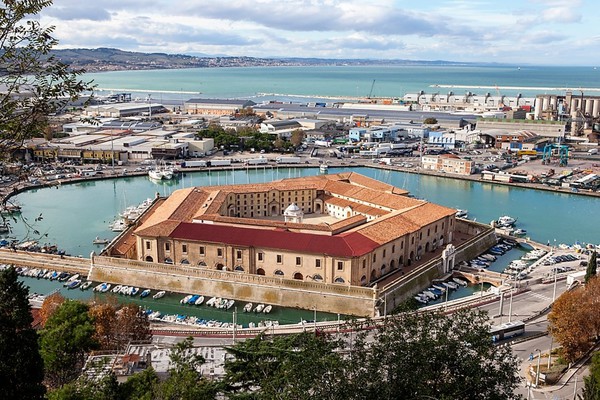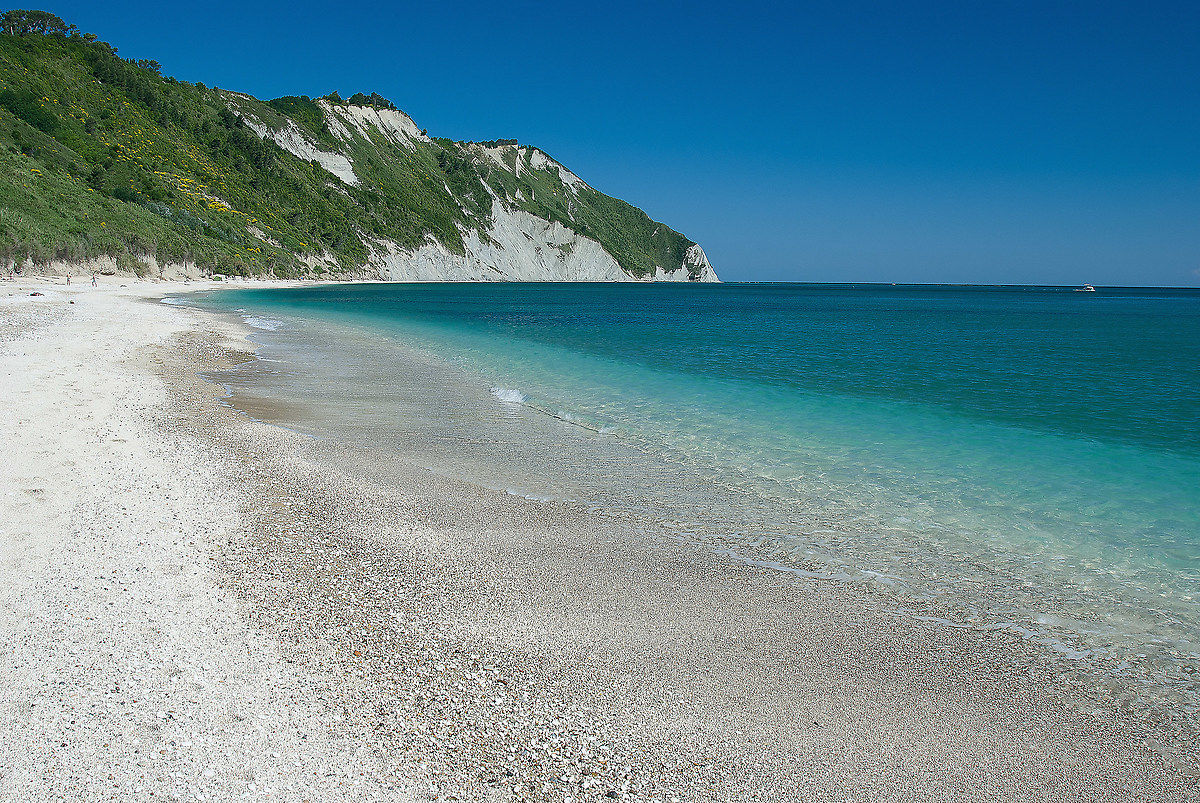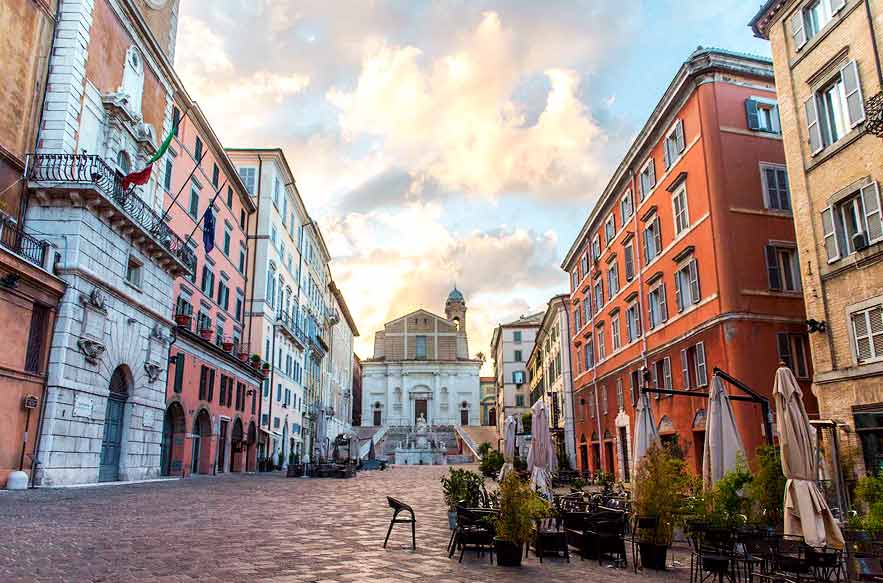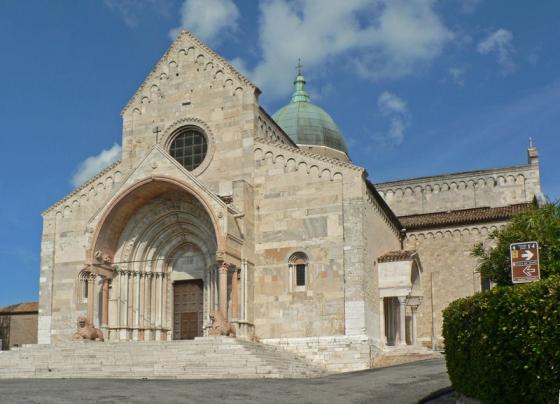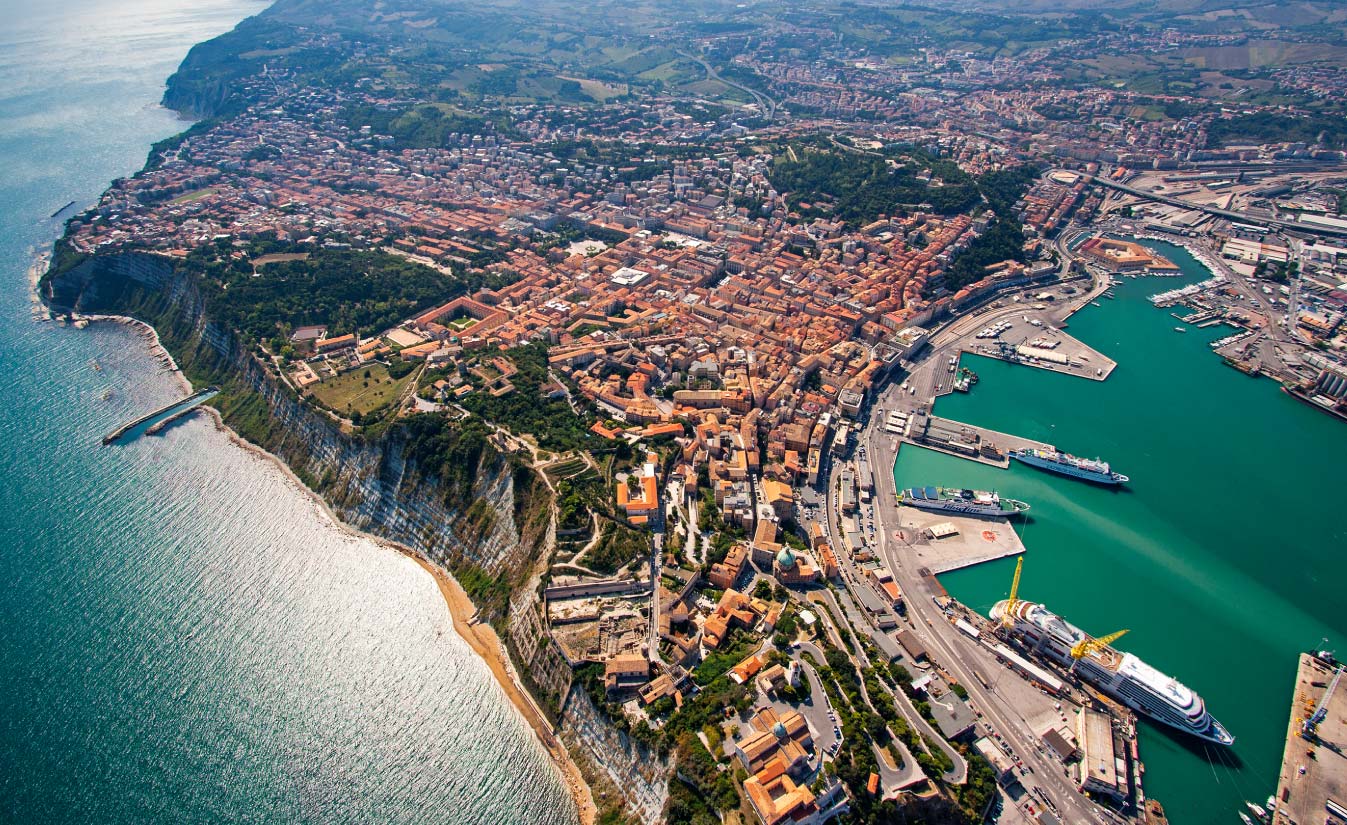Ancona
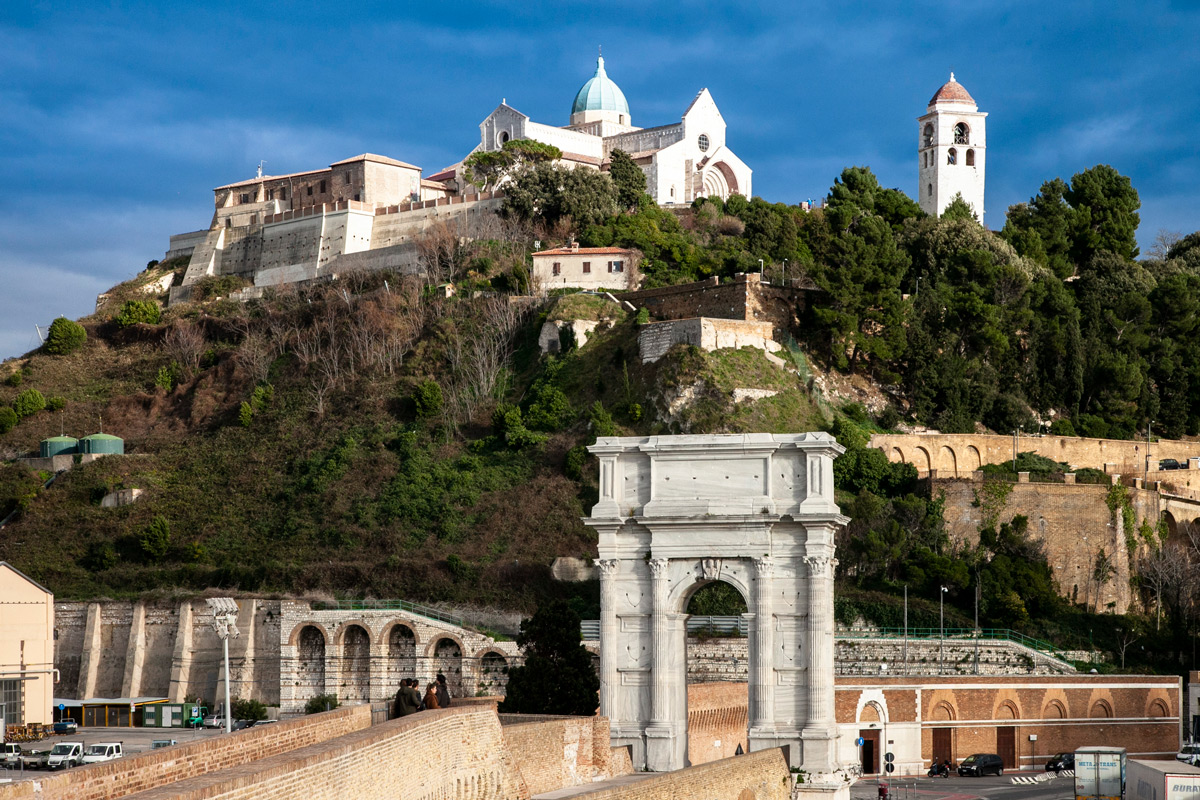
Distance from Sirolo: 19 km. Leave Sirolo towards Monte Conero and, then go straight towards Ancona.
Historical outline
Some traces of pre-historical settlements and of the Piceni’s civilization have been found. In the early fourth century B.C. it became an important Doric colony called Ancòn (greek: elbow) according to the natural inlet where the port is located; the city has always been linked to the port. It became an important port of call under the Romans and, in particular, under Traiano. After the falling of the Longobards it was submitted to the Church of Rome. After having undergone the destruction by the Saracens in 839, it slowly flourished again. It became a free Commune and underwent several sieges; one of them was carried out by Federico Barbarossa and the Venetian fleet. Successively, the Malatesta Dynasty took hold of it but it became free again. Then, a serious economic crisis took place when Costantinopoli, its partner in a successful business, was conquered by the Turkish. Over the fifteenth century it was an important Maritime Republic until 1532 when it was occupied by the Church. Between 1797 and 1816, because of the French occupation, it was the centre of the patriotic risings of the Risorgimento of the Marche region until 1860. It was dangerously bombed during both the World Wars, undergoing the destruction of the most medieval and Renaissance area.
Coming from the road of the Monte, stop at the Passetto to admire the wonderful panorama and the war memorial: it is a little,
circle-shaped temple built on eight Doric columns made by stones from Istria.
Going along Viale della Vittoria you can find the Stamira car park (properly indicated) where it is possible to park your car. On foot, follow the road signs indicating the Teatro delle Muse and enter the Piazza Kennedy and the adjoining Piazza della Repubblica. On the façade of the Teatro delle Muse you can see, on the tympanum, a bas-relief representing Apollo and the Muses. In the same square, the Chiesa del S.S. Sacramento (1538) is located; it was rebuilt in the eighteenth century in accordance to the neoclassical model. The particular winding cusp on the bell-tower is worth mentioning. From Piazza Kennedy, at the beginning of Via Cialdini, on the façade of the ex-Chiesa di Sant’Agostino, you can admire the big portal built in flowery, Venetian, Gothic style (1475). On the right side of the theatre (Teatro delle Muse), go on along the Via Gramsci till Piazza del Plebiscito, also called Piazza del Papa because of the statue representing Clemente XII which is located at the end of the square, near the beautiful fountain dating back to 1449. In the square, which is considered as the sitting room of Ancona (many summer outdoor shows take place there), Palazzo del Governo (XIV century) with the Torre Civica (public tower) is situated. In the same square the municipal library, the historic archive and the museum are located. A staircase and two side flights lead to the Chiesa di S. Domenico which is to be visited thanks to the “Crocifissione”(Crucifiction) by Tiziano and the “Annunciazione”(Annunciation) by Guercino. If tourists love painting, they have to visit the Pinacoteca (picture-gallery) Francesco Podesti and the Modern Art Gallery, near Palazzo Bosdari. Come back to Piazza del Papa and come along the same road upwards until Piazza S. Francesco where, on the right side, the Chiesa di S. Francesco delle Scale or Santa Maria Maggiore (1323) is situated. The big, Venetian, Gothic portal and the painting by Lorenzo Lotto, situated in the apse, representing the “Assunta” are noteworthy. Going upwards, on the right side of the road, the Chiesa del Gesù (1665), with a façade by Vanvitelli, is located; in front of it there is Palazzo degli Anziani (1270). Further ahead, you can visit the Museo Archeologico Nazionale delle Marche which contains very interesting collections related to the Iron Age, the Piceni civilization, the Greeks,the Gauls and the Romans. During the years some sections relating to the Bronze, Palaeolithic and Neolithic Age have been added. Don’t miss it! Going upwards you can get to Piazza del Senato where the Palazzo del Senato is located on the right side; it was built in the early thirteenth century. In front of it, there are the big ruins of the Anfiteatro Romano (the Roman amphitheatre) dating back to the first century A.D.; on the left side the Chiesa dei SS. Pellegrino e Teresa is situated.
Near the church there is an uphill leading to the top of Colle Guasco; in this place there is a large square flanked by the beautiful Cattedrale (Cathedral) dedicated to S. Ciriaco. It was built on the basement of a Hellenic temple dating back to the third century B.C., which was probably destroyed by a terrible earthquake in 558. At first, an early Christian basilica was built (VI century); it was dedicated to S. Lorenzo. The building is formed by three naves and the entrance is situated on the south-eastern side; it was partially destroyed by the Saracen incursions. Between the eleventh and the twelfth century it was enlargened and its structure became a Greek-cross shaped one. It had been enlarging until the fourteenth century when the Church was dedicated to S. Ciriaco, bishop and martyr, patron saint of the Maritime Republic of Ancona. The beautiful façade is shown in every book of Art History. On the top of the staircase, you can see four columns (two of them were added by Vanvitelli) whose basis are formed by two red-granite lions coming from Verona. The Gothis-Romanesque portal is made by white and red stones coming from the Conero (1228). The façade shows three openings: the big, central rose window and two single lancet windows on the side naves. On the right side, the bell tower is situated; its shape is squat because it derives from the pre-existing military tower. On the left side of the church you can see the ex-Palazzo Vescovile, a very ancient monastery, which is now the seat of the Museo Diocesano. After having visited the Cathedral dedicated to S. Ciriaco and having admired the beautiful view over the port, you can go downwards through Via Giovanni XXIII. On the right side of the first hairpin bend, there is the Casa del Boia (the Headsman’s House) where, according to the tradition, the headsman of the city lived.
Come down until Piazza Dante Alighieri and then go on along the seafront Vanvitelli until the Arco di Traiano, a wonderful Roman work of art attributed to Apollodoro from Damasco (115 A.D.) which was built in order to thank the Emperor who let Ancona become the main Roman port of the Adriatic Sea. Nearby, you can see the Arco Clementino (1738), a Neoclassical work by Vanvitelli, dedicated to Clemente XII; further on, isolated in the area of the port, the massive Lazzaretto or Mole Vanvitelliana is situated; over the years, this building has had different roles: quarantine zone, hospital, barracks, prison, bonded warehouse, tobacco warehouse. Then, come back to Piazza Dante Alighieri and take Via Saffi until the Chiesa di S. Maria, situated in the same square. It was built between the eleventh and the twelfth century on pre-existing foundations of an early Christian basilica; it is a suggestive sample of the Romanesque style of the Marche region. The beautiful façade, which is built in accordance with the shape of the three naves, is covered by Dalmatian marble on the lower part and it is enriched with two horizontal lines of decorations. The friezes that frame the portal are wonderful. Then, you can go on and visit Loggia dei Mercanti, made by a beautiful, flowery Gothic façade; close to that there is Palazzo Benincasa. Corso Stamira, which leads to the car park, is not far from there. Coming back to the road which leads to the Riviera del Conero (called Strada del Monte) towards Sirolo, after 11 km, turn left towards PORTONOVO. The street ends with the Chiesa di S. Maria di Portonovo (1034 – 48), a typical, beautiful sample of the Romanesque architecture; its shape is unique in Italy but not so rare in Normandy or in Corsica. This church is formed by three naves but it shows a particular element: it has to half, side naves. In the past, it was a Benedictine abbey which was abandoned because of the landslides coming down from the mountain. At the end of the pebbly beach in Portonovo, you can see the big Fortino Napoleonico (1808) which was built by French in order to defend the coast against the English assaults. Now, it is a hotel. Not far from there, the Torre di Guardia is situated; it is a lookout tower (1716) ordered by Clemente XI. It also accomodated D’Annunzio.
Going back towards Sirolo along the road to the Monte you get past Poggio and Massignano; after them, turn left towards the top of the Monte COnero where the Badia S. Pietro is worth mentioning. It is a Romanesque-styled building which was, at first, a
Benedictine hermitage and, then, it became a Camaldolite one (XI century). From this place you can admire the beautiful view: the whole southern coast surrounded by hills where Loreto, Castelfidardo, Recanati and Osimo are situated. Behind these hills, you can see the Monti Sibillini and, in particular, the Monte Vettore (m. 2476).
MORE INFO: www.anconatourism.it

